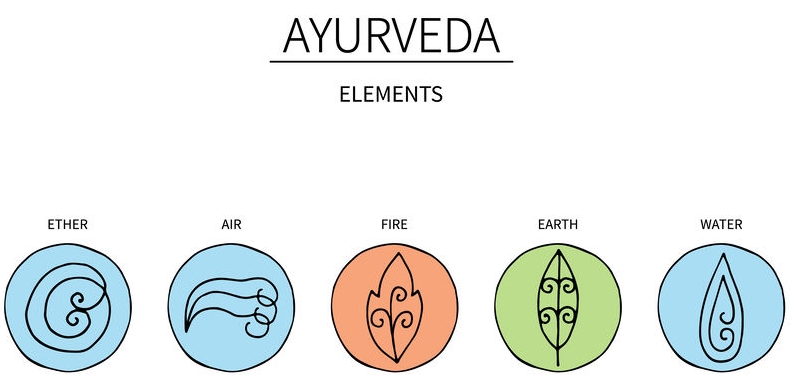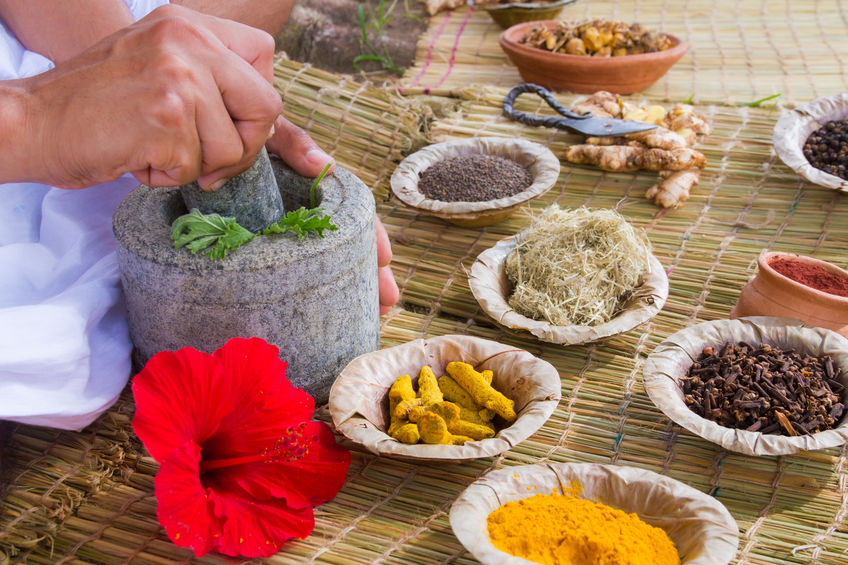Introduction to Ayurveda – Understanding & Balancing the Doshas
If you’re even remotely interested in wellness and health, you would have certainly heard about Ayurveda. This ancient Indian medicinal practice is over 5000 years old and over the years, due to its efficacy and unique approach, has become a global phenomenon.
Ayurvedic medicine focuses specifically on prevention, as opposed to simply curing the symptoms. The Ayurvedic practice relies on promoting wellness and good health by steadying the delicate balance between a person’s mind, spirit, and physical body.
Ayurvedic practice also states that a person’s ‘dosha’ or humors (bodily governing energies), determines their health, mental state, personality, and more. These doshas are a key element when it comes to making Ayurvedic medicine work for you.
However, before we take a look at these doshas and what they actually mean, let’s first understand more about the concept of ‘Pancha Mahabhutas’.
Pancha MahaBhuta – The Five Key Elements of Life
Ayurveda believes that we all are small samples of the world around us. This means that according to Ayurveda, we are made up of the very elements that make up our universe. These key elements of life of ‘Pancha MahaBhutas’ are vayu (air), jala (water), akash (space), teja (fire), and prithvi (earth).
So, whether it’s a living organism or a non-living object, Ayurvedic medicine believes that we all contain these elements within us, in varying degrees. These key elements come together to for the three ‘doshas’ or humors (bodily governing energies). The harmonious the balance of our doshas are necessary to maintain good health, strong immunity, mental strength, and much more. When these elements (and by extension, doshas) are imbalanced, we experience illness, sickness, disease, and other unfavourable conditions.

The Three Doshas in Ayurveda
As we mentioned before, Ayurvedic medicine focuses on balancing the bodily energies to promote wellness and good health. It focuses on harmonizing the doshas, called as Vata, Pitta and Kapha.
The three doshas are important as they serve as ‘healthy types.’ They help Ayurvedic medicine experts determine the person’s strengths, weaknesses, and can also help understand the right diet, lifestyle, and sleep schedule for each person.
Contrary to popular belief, it’s not only one dosha that governs our body. Every person has different amounts of each dosha within them. The goal with an Ayurvedic diet and lifestyle is to harmonize the balance of your doshas back to how they naturally exist in your body.
Now that we’ve understood exactly what the doshas do for us, let’s take a look at each of these doshas, their characteristics, and a few easy tips to balance them.
Vata Dosha
What are the characteristics of Vata Dosha?
‘Vata’ dosha is an amalgamation of elements like air and space (ether), and manages all the movements in our mind and body. Often associated with the wind, this dosha is associated with creativity, mental energy, and free-spirited nature. The role of Vata, in short, is to govern emotional sensitivity and mental mobility. This dosha is also associated with key bodily processes like muscle movement, cardiovascular function, and breathing.
A person with Vata Dosha dominance usually has a light, thin build. Such individuals also have dry skin, thin hair, irregular hunger or appetite, and need less sleep. They may also feel cold easily and experience incessantly racing thoughts. If someone has an imbalanced Vata dosha, it often manifests as fear, obsessive thoughts, restlessness, anxiety, muscle spasms, and even digestive issues like constipation.
The Vata personality’s strengths are innumerable. They are quick learners, highly creative thinkers, multi-taskers, and inspirational teammates.
How can you balance Vata Dosha?
When Vata energies are balanced, it helps you be more creative, level-headed, energetic, and inspiring. So, let’s take a quick look at some pointers that will help you balance your Vata dosha.
- One of the best ways to balance Vata energies is to practice grounding meditation. It can be as simple as walking on the earth bare feet, or as elaborate as setting a meditation and mindfulness regime.
- Limiting use of technology, especially an hour before bed, can help you be more relaxed and aids in quelling excessive thoughts.
- Vata dosha dominance often leads to dryness within the body. To counter this, it’s best to stay adequately hydrated.
- Vata dosha’s resulting dryness is eased by eating cooked food, as opposed to raw food. So, ensure that you add generous amounts of high-quality, cold-pressed oils, and ghee to your meals.
- Naturally moist foods like berries, melons, citrus fruits, squash, zucchini, stone fruits and even yogurt an aid in combatting vata’s drying quality. You can also include soups, stwes, curries, and broths to your daily diet. Veda5’s Vata Tea is also a great addition to your morning dosha-balancing routine.
- One of the best answers to the question of how to balance vata dosha lies in avoiding cold or frozen foods. Instead, opt for room-temperature or warmer meals.
- Another key way to balance vata dosha is to incorporate regular massages and therapies designed to work on Vata energies. Try specialized products like Veda5’s Vata Massage Oil and Veda5’s herbal therapeutic potli to get the best results.
Pitta Dosha
What are the characteristics of Pitta Dosha?
Pitta dosha controls heat, metabolism and energetic transformation in the mind and body, as well as the essential digestive “Agni” or fire of the body. This dosha is linked to the element of fire, combined with water. The role of Pitta, in short, is to govern reason and intelligence in every individual. This dosha is also associated with key processes related to the metabolic, digestive, and endocrine system in the body.
A person with Pitta Dosha dominance usually has a medium build. Such individuals also have a tendency to feel hot or warm easily. With robust metabolisms and healthy appetites, such individuals also have a good digestive system. They tend to be highly-competitive, energetic, ambitious, intelligent, high-achieving, and ambitious. Many Pitta personalities are night owls, but they tend not to suffer from sleep-related problems. Instead, they are deep sleepers, prone to having frequent and vivid dreams.
When imbalanced, Pitta dosha manifests itself as uncontrollable anger, rage, burnout, irritation, irrationality, and even skin breakouts, acne, or rashes.
How can you balance Pitta Dosha?
When Pitta energies are balanced, it helps you be more focused, energetic, and gives you a sense of self-confidence. So, let’s take a quick look at some pointers that will help you balance your Pitta dosha.
- Pitta is the manifestation of ‘fire’ element. So, it comes as no surprised that those with an underactive or overactive pitta dosha benefit from foods and activities that have a cooling effect. Right from cold showers, swimming in cool water bodies, drinking cool beverages, and even walking near a water body can help balance Pitta dosha.
- Avoid foods that are too spicy, extremely hot, or overtly fermented. These should be consumed in small amounts and with less frequency, as they can lead to an imbalanced pitta dosha.
- Astringent foods are great when it comes to pacifying pitta, which is why you should include them in your meals. The best legumes for pitta balancing includes kidney beans, black beans, chickpeas, moong dal, and black-eyed peas.
- Wear breathable and cooling fabrics to keep your body cool. Avoid synthetic fabrics and stick to cotton and linen.
- Most nuts and seeds contain a very high oil content, making them unfavourable as a part of the pitta diet chart. However, soaked almonds, pumpkin seeds, sunflower seeds, flaxseed and coconut can be consumed in moderation.
- You can also add Veda5’s Pitta Balancing Tea and Veda5’s Pitta Massage oil to your everyday routine. Designed by Ayurvedic experts, these products are ideal for balancing pitta dosha.
Kapha Dosha
What are the characteristics of Kapha Dosha?
Kapha dosha gives structure and robustness to living beings. It essentially helps maintain forms by providing cohesiveness. This dosha is often associated with the elements of earth and water, and governs feeling and emotions. Kapha dosha acts as a stabilizing energy that supplies and regulates water in the body and maintains the immune system.
A person with Kapha Dosha dominance usually has a heavy build. Such individuals tend to be calm, collected, grounded and have a forgiving nature. Their skin is on the oiler side of the spectrum and they have thick hair growth. Those with Kapha dosha dominance usually have restful sleep patterns and are known to be patient, rational, and compassionate.
When imbalanced, Kapha dosha manifests itself as loss of enthusiasm, laziness, sluggishness, jealousy, and even weight gain, fluid retention, bloating, or fatigue.
How can you balance Kapha Dosha?
When Pitta energies are balanced, it strengthens your immune system, allows you to be more serene, and gives you a sense of mental peace. So, let’s take a quick look at some pointers that will help you balance your Kapha dosha.
- Kapha personalities greatly benefit from a daily exercise routine that allows them to stay fit. Yoga, running, swimming, walking, and even aerobics are beneficial.
- Warm beverages like Veda5’s Kapha Balancing Tea, soups, stews and other concoctions are helpful. Use kapha-stimulating spices like ginger, cloves, cinnamon, nutmeg, and even peppercorns generously.
- Nasal cleansing with a neti pot is also useful in balancing Kapha dosha as it aids in removing respiratory. Similarly, steam inhalation and aromatherapy with specific products like Veda5’s Kapha Massage oil are recommended.
- Fresh fruit and vegetable juices can help eliminate excess kapha from the body, so if you have an overactive Kapha dosha, make sure to include plenty of natural fluids in your diet.
- Kapha is often aggravated by sweeteners, both artificial and natural. However, you can use honey in place of your regular sweeteners to keep your Kapha energies balanced.
- Stick to light and easy-to-digest fats like olive oil, sunflower oil, almond oil, or even pure ghee. Consumer pumpkin or sunflower seeds over heavy options like cashews or pistachios.

